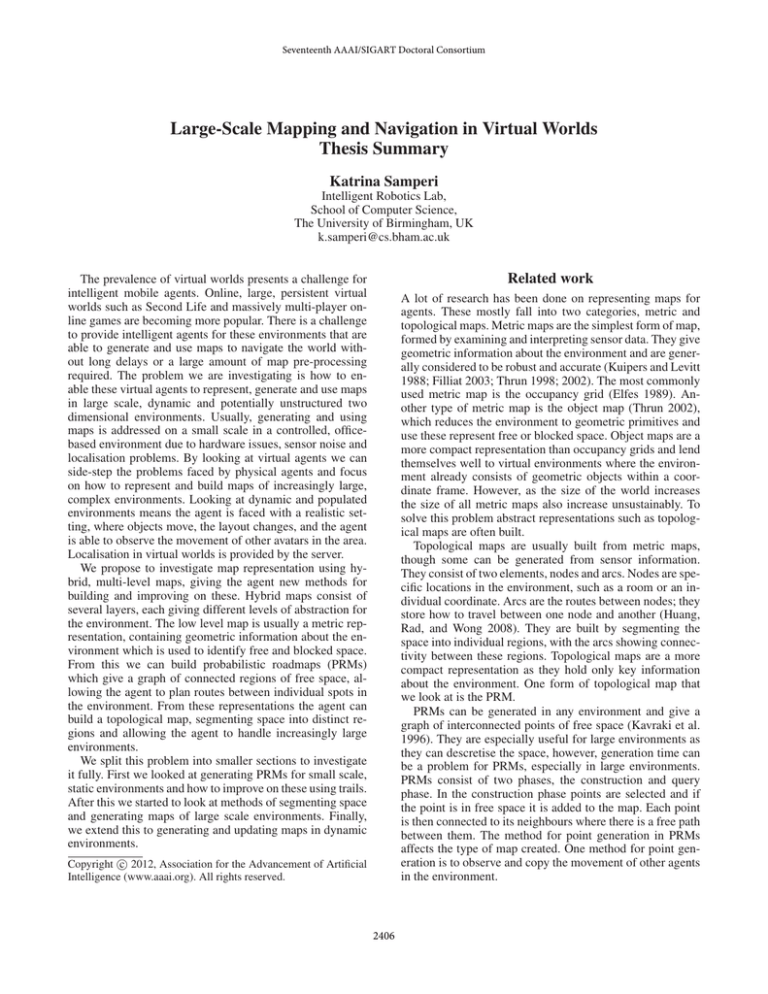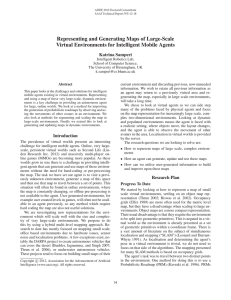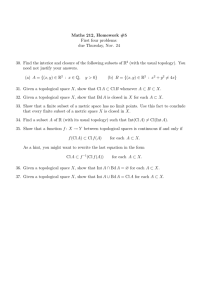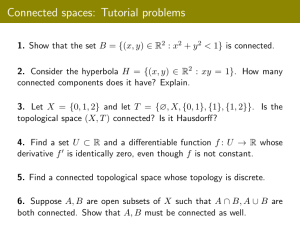
Seventeenth AAAI/SIGART Doctoral Consortium
Large-Scale Mapping and Navigation in Virtual Worlds
Thesis Summary
Katrina Samperi
Intelligent Robotics Lab,
School of Computer Science,
The University of Birmingham, UK
k.samperi@cs.bham.ac.uk
Related work
The prevalence of virtual worlds presents a challenge for
intelligent mobile agents. Online, large, persistent virtual
worlds such as Second Life and massively multi-player online games are becoming more popular. There is a challenge
to provide intelligent agents for these environments that are
able to generate and use maps to navigate the world without long delays or a large amount of map pre-processing
required. The problem we are investigating is how to enable these virtual agents to represent, generate and use maps
in large scale, dynamic and potentially unstructured two
dimensional environments. Usually, generating and using
maps is addressed on a small scale in a controlled, officebased environment due to hardware issues, sensor noise and
localisation problems. By looking at virtual agents we can
side-step the problems faced by physical agents and focus
on how to represent and build maps of increasingly large,
complex environments. Looking at dynamic and populated
environments means the agent is faced with a realistic setting, where objects move, the layout changes, and the agent
is able to observe the movement of other avatars in the area.
Localisation in virtual worlds is provided by the server.
We propose to investigate map representation using hybrid, multi-level maps, giving the agent new methods for
building and improving on these. Hybrid maps consist of
several layers, each giving different levels of abstraction for
the environment. The low level map is usually a metric representation, containing geometric information about the environment which is used to identify free and blocked space.
From this we can build probabilistic roadmaps (PRMs)
which give a graph of connected regions of free space, allowing the agent to plan routes between individual spots in
the environment. From these representations the agent can
build a topological map, segmenting space into distinct regions and allowing the agent to handle increasingly large
environments.
We split this problem into smaller sections to investigate
it fully. First we looked at generating PRMs for small scale,
static environments and how to improve on these using trails.
After this we started to look at methods of segmenting space
and generating maps of large scale environments. Finally,
we extend this to generating and updating maps in dynamic
environments.
A lot of research has been done on representing maps for
agents. These mostly fall into two categories, metric and
topological maps. Metric maps are the simplest form of map,
formed by examining and interpreting sensor data. They give
geometric information about the environment and are generally considered to be robust and accurate (Kuipers and Levitt
1988; Filliat 2003; Thrun 1998; 2002). The most commonly
used metric map is the occupancy grid (Elfes 1989). Another type of metric map is the object map (Thrun 2002),
which reduces the environment to geometric primitives and
use these represent free or blocked space. Object maps are a
more compact representation than occupancy grids and lend
themselves well to virtual environments where the environment already consists of geometric objects within a coordinate frame. However, as the size of the world increases
the size of all metric maps also increase unsustainably. To
solve this problem abstract representations such as topological maps are often built.
Topological maps are usually built from metric maps,
though some can be generated from sensor information.
They consist of two elements, nodes and arcs. Nodes are specific locations in the environment, such as a room or an individual coordinate. Arcs are the routes between nodes; they
store how to travel between one node and another (Huang,
Rad, and Wong 2008). They are built by segmenting the
space into individual regions, with the arcs showing connectivity between these regions. Topological maps are a more
compact representation as they hold only key information
about the environment. One form of topological map that
we look at is the PRM.
PRMs can be generated in any environment and give a
graph of interconnected points of free space (Kavraki et al.
1996). They are especially useful for large environments as
they can descretise the space, however, generation time can
be a problem for PRMs, especially in large environments.
PRMs consist of two phases, the construction and query
phase. In the construction phase points are selected and if
the point is in free space it is added to the map. Each point
is then connected to its neighbours where there is a free path
between them. The method for point generation in PRMs
affects the type of map created. One method for point generation is to observe and copy the movement of other agents
in the environment.
c 2012, Association for the Advancement of Artificial
Copyright Intelligence (www.aaai.org). All rights reserved.
2406
Trails are from a concept used in urban architecture; they
show the routes taken by agents in an environment, rather
than the paths intended for use. Trails have been used in virtual environments to aid human navigation (Ruddle 2005)
and also as a starting point for a robot’s map building process (Yuan, Twardon, and Hanheide 2010). A digital trail is
defined as the list of points an agent has been observed at
over time.
can be used to generate more successful PRMs which allow
for shorter routes to be planned. We expect that by using
cluster points we can segment space allowing the agent to
generate maps for any size of environment. Learning how to
build better maps is an interesting problem and one which
requires investigation. If the agent is able to generate better
starting maps based on previous information then it will have
an advantage in updating these maps over time.
Progress to date
Timeline
The first step in solving our problem was resolving how to
represent and generate a map of the environment. We used
PRMs to allow an agent to plan a route between two points.
Our hypothesis was that we could improve PRM generation
by using trail information to build the map both to indicate
popular routes and decide if a point lies in free space. A good
PRM will allow the agent to plan a route between any two
points in space, plan relatively short routes and be generated
in a short amount of time. Trail points can be used as the
selected points in a PRM and the routes taken used to form
arcs. After investigation, we have shown that the combination of using trails and randomly selected points in PRMs
enables the agent to generate maps which are more successful at finding routes and generating shorter paths. However,
the use of trails increases the generation time of the map.
The second step is addressing how to segment space, allowing an agent to build topological maps and maps of very
large-scale environments. It is important that the agent segment the space intelligently, so that areas that relate to one
another are kept within a single region else the map will require more upkeep long term. There are numerous methods
for doing this, but the best approach will take into account
any structure in the world. Following on from trail points, we
can look at where large groups of people congregate in the
world. These cluster-points show important places in the environment and how places relate to one another. One method
of segmenting space is to use the cluster points as Voronoi
seed points (Thrun 1998), giving a map that attempts to keep
important places in the center of each node. This work we
expect to have finished by July.
This section covers a brief timeline of my expected activities
over the rest of my degree.
• February-March: Investigate clustering and segmenting
space. Write up results
• April-May: Investigate topological maps and segmenting
large-scale environments
• June-July: Dynamism in maps, how to keep the map up to
date and know what needs changing
• August-October: Learning maps based on previous
knowledge and movements
• October-November: Start writing up thesis. Skeletal outline of most chapters
• December-January 2013: Literature review
• February: Improving probabilistic roadmaps using trails
• March: Segmenting space for large scale maps
• April: Dynamic large scale maps
• May: Conclusion and Introduction
• June-August: Proof reading and submission
References
Elfes, A. 1989. Using occupancy grids for mobile robot perception
and navigation. Computer 22:46–57.
Filliat, D. 2003. Map-based navigation in mobile robots: I. a review
of localization strategies. Cognitive Systems Research 4(4):243–
282.
Huang, G.; Rad, A.; and Wong, Y. 2008. A new solution to map
dynamic indoor environments. International Journal of Advanced
Robotic Systems.
Kavraki, L.; Svestka, P.; Latombe, J.-C.; and Overmars, M. 1996.
Probabilistic roadmaps for path planning in high-dimensional configuration spaces. Robotics and Automation, IEEE Transactions on
12(4):566 –580.
Kuipers, B. J., and Levitt, T. S. 1988. Navigation and mapping in
large-scale space. AI MAGAZINE 9:25–43.
Ruddle, R. 2005. The effect of trails on first-time and subsequent
navigation in a virtual environment. In VR ’05: Proceedings of
the 2005 IEEE Conference 2005 on Virtual Reality, 115–122, 321.
Washington, DC, USA: IEEE Computer Society.
Thrun, S. 1998. Learning metric-topological maps for indoor mobile robot navigation. Artif. Intell. 99(1):21–71.
Thrun, S. 2002. Robotic mapping: A survey. In Lakemeyer, G.,
and Nebel, B., eds., Exploring Artificial Intelligence in the New
Millenium. Morgan Kaufmann.
Yuan, F.; Twardon, L.; and Hanheide, M. 2010. Dynamic path
planning adopting human navigation strategies for a domestic mobile robot. In Intelligent Robots and Systems, 3275–3281.
Future plans
The final stage in solving our problem is to look at how to
generate and update maps of dynamic environments. The
construction cost of changing virtual worlds is low, so they
tend to change rapidly. This requires the agent to update its
map, and recognise when changes occur both gradually and
without warning. An interesting problem is detecting new
cluster points as they emerge, which potentially causes the
topological map to change. We could also use trails to show
where free space may have altered. If someone is observed
moving through previously blocked areas the agent knows
the map requires an update. It may be possible for the agent
to use knowledge gained from generating maps of previous
environments to augment this process. We plan to have this
section complete by October 2012.
The anticipated contribution of this thesis is a new method
for representing and generating maps of large scale, dynamic
and unstructured environments. We have shown that trails
2407




